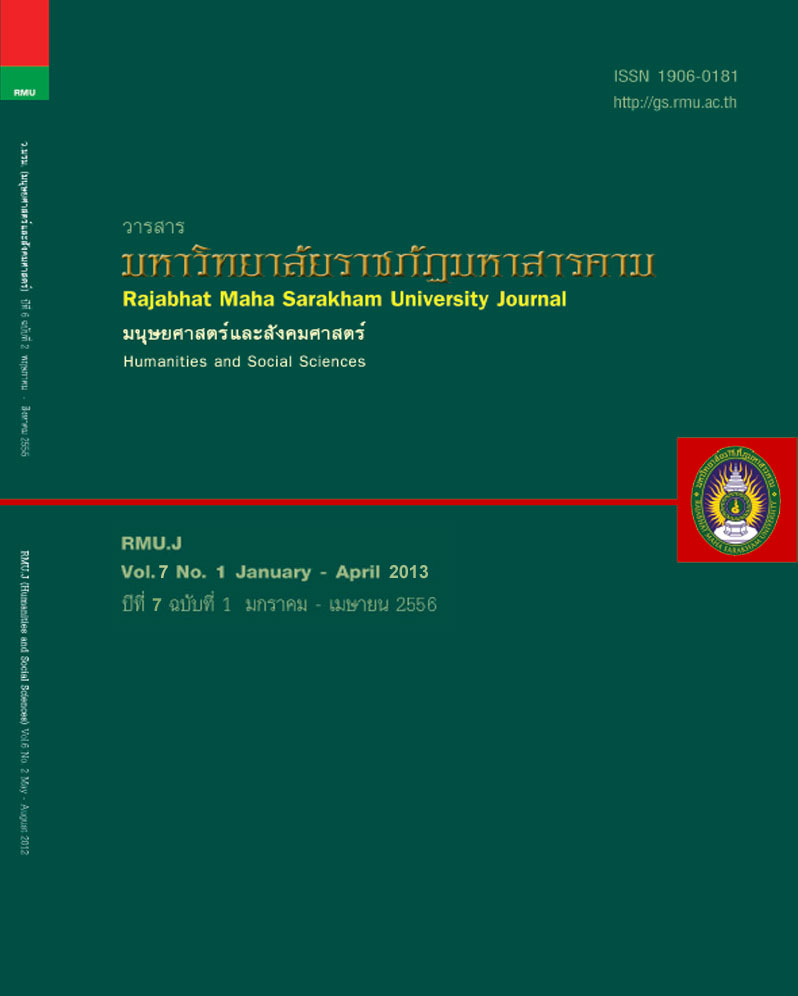การสร้างแบบวัดความสามารถในการคิดวิเคราะห์ สำหรับนักเรียนชั้นมัธยมศึกษาปีที่ 4
Main Article Content
Abstract
บทคัดย่อ
การวิจัยครั้งนี้มีวัตถุประสงค์ เพื่อสร้างและหาคุณภาพเกณฑ์ปกติของแบบวัดความสามารถในการคิดวิเคราะห์ สำหรับนักเรียน ชั้นมัธยมศึกษาปีที่ 4 แบบวัดความสามารถในการคิดวิเคราะห์ที่สร้างขึ้นประกอบด้วยการวิเคราะห์ความสำคัญ การวิเคราะห์สัมพันธ์ และการวิเคราะห์หลักการ ประชากรที่ใช้ในการวิจัยเป็นนักเรียนชั้นมัธยมศึกษาปีที่ 4 ภาคเรียนที่ 1 ปีการศึกษา 2554 สังกัดเขตพื้นที่ การศึกษามัธยมศึกษา เขต 27 จำนวน 10,053 คน กลุ่มตัวอย่างได้มาโดยการสุ่มแบบหลายขั้นตอน จำนวน 445 คน เครื่องมือที่ใช้ วิจัยในครั้งนี้ประกอบด้วยแบบวัดความสามารถในการคิดวิเคราะห์ สำหรับนักเรียนชั้นมัธยมศึกษาปีที่ 4ๆ ผลการวิจัย พบว่า
1. ผลการสร้างแบบวัดความสามารถในการคิดวิเคราะห์ สำหรับนักเรียนชั้นมัธยมศึกษาปีที่ 4 ได้ข้อสอบปรนัย ชนิดเลือกตอบ 4 ตัวเลือก จำนวน 40 ข้อ
2. ผลการหาคุณภาพของแบบวัดความสามารถในการคิดวิเคราะห์ สำหรับนักเรียนชั้นมัธยมศึกษาปีที่ 4 มีคุณภาพเป็นที่ยอมรับ ได้ นั่นคือ มีความเที่ยงตรงเชิงเนื้อหาโดยผู้เชี่ยวชาญมีค่าดัชนีความสอดคล้อง (IOC) อยู่ระหว่าง .60 -1.00 อำนาจจำแนกรายข้อมี ค่าอยู่ระหว่าง .42 - .84 ความยากมีค่าอยู่ระหว่าง .21 - .80 และความเชื่อมั่นทั้งฉบับมีค่าเท่ากับ 0.90 ความเที่ยงตรงเชิงโครงสร้าง มีดัชนีวัดระดับความสอดคล้องกลมกลืนระหว่างโมเดลการวิจัยกับข้อมูลเชิงประจักษ์โดยการวิเคราะห์องค์ประกอบเชิงยืนยันพบว่า ดัชนีการวัดระดับความกลมกลืน (GFI) มีค่าเท่ากับ 0.92 ดัชนีระดับความกลมกลืนที่ปรับแล้ว (AGFI) มีค่าเท่ากับ 0.87 ดัชนีรากของ ค่าเฉลี่ยกำลังสองของส่วนที่เหลือ (RMR) มีค่าเท่ากับ 0.046 Chi-square () มีค่าเท่ากับ 570.83 ระดับองศาอิสระ (df) มีค่าเท่ากับ 521 และ RMSEA มีค่าเท่ากับ 0.006 และระดับนัยสำคัญทางสถิติ (p) มีค่าเท่ากับ 0.06547
3. ผลการสร้างเกณฑ์ปกติ (Norms) ของแบบวัดความสามารถในการคิดวิเคราะห์ สำหรับนักเรียนชั้นมัธยมศึกษาปีที่ 4 ที่ผู้วิจัย สร้างขึ้น เมื่อนำมาเทียบกับเกณฑ์ปกติที่ระบุไว้ พบว่าส่วนใหญ่อยู่ในระดับพอใช้
คำสำคัญ : การสร้างแบบวัดความสามารถในการคิดวิเคราะห์
ABSTRACT
This research aimed to: 1) construct a test of analytical thinking ability for Mattayom Sueksa 4 students , and 2) determining the quality of the test of, and 3) develop norms of the test of analytical thinking ability for Mattayom Sueksa 4 students’. The test was constructed based on significance analysis, relation analysis and principle analysis. The research subjects were 10,053 Mattayom Sueksa 4 students studying in the schools under the Office of Secondary Education Area 27 in the first semester of the academic year 2011. The sample consisted of 445 Mattayom Sueksa 4 students obtained through the multi-stage random sampling technique. The instrument used for data collection in this study was the constructed test for evaluating Mattayom Sueksa 4 students’ analytical thinking ability.
The results of the study are as follows:
1. Obtained from the present study was a 40-item, four- multiple-choice constructed test of analytical thinking ability for Mattayom Sueksa 4 students.
2. The test constructed for evaluating Mattayom Sueksa 4 students’ analytical thinking ability met the acceptable quality criteria; that is, the content validity of the test determined by the experts showed the index objective of congruence (IOC) of .60-1.00, the power of discrimination of .42-.84, the difficulty index of .21- .80, and the test reliability of 0.90. Its construct validity index of congruence between the research model and the empirical data through confirmatory factor analysis (CFA) showed its goodness of fit index (GFI) of 0.92, adjusted goodness fit index (AGFI) of 0.87, the root mean square residual (RMR) of 0.046, the Chi-Square test () of 570.83, the degree of freedom (df) of 521, the root mean square error of approximation (RMSEA) of 0.006, and the statistical significance (p-value) of 0.06547.
3. The norms of the test constructed for evaluating Mattayom Sueksa 4 students’ analytical thinking ability, as compared with the established norms, were mostly found at a moderate level.
Keywords : constructing a test, analytical thinking ability, Mattayom Sueksa 4 students
Article Details
1. All articles undergo a thorough with at least three reviewers evaluating their suitability within the respective field of study, during the double-blind review.
2. The views expressed by individual authors do not represent the official views of the Editorial Boards of RMUJ: The author of each articie is responsible for all its contents.
3. The Editorial Boards do not reserve the copyrights. but proper citations need to be made.

